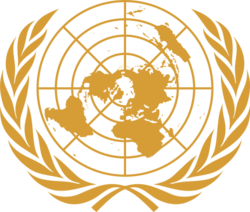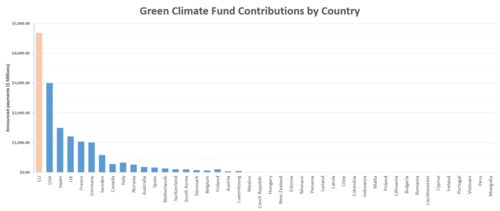Earth:Green Climate Fund
 | |
 | |
 ` | |
| Legal status | Active |
|---|---|
| Headquarters | Songdo International Business District, Yeonsu-gu, Incheon, South Korea |
| Website | GreenClimate.fund |
The Green Climate Fund (GCF) is a fund established within the framework of the UNFCCC as an operating entity of the Financial Mechanism to assist developing countries in adaptation and mitigation practices to counter climate change. The GCF is based in Incheon, South Korea . It is governed by a Board of 24 members and supported by a Secretariat.
The objective of the Green Climate Fund is to "support projects, programmes, policies and other activities in developing country Parties using thematic funding windows".[1] It is intended that the Green Climate Fund be the centrepiece of efforts to raise Climate Finance under the UNFCCC. The current executive director is Yannick Glemarec.[2]
History
Wealthier, industrialized countries have been the countries responsible for most greenhouse gas emissions.[3][4] As a consequence, it has been argued that these countries are morally responsible to pay for a lion's share of the cost of climate mitigation worldwide, including costs of the transition of less developed and least developed countries.[5][6] A number of civil society groups determined that the United States and the European Union are morally responsible for at least 54% of the cost of mitigating climate change-driven disaster damage in the Global South.[7] Others have argued that wealthier countries should help finance the transition of less developed and least developed countries because the former can more realistically afford the substantial investment now urgently needed for the transition.[8]
The Copenhagen Accord, established during the 2009 United Nations Climate Change Conference (COP-15) in Copenhagen mentioned the "Copenhagen Green Climate Fund". The fund was formally established during the 2010 United Nations Climate Change Conference in Cancun as a fund within the UNFCCC framework.[9] Its governing instrument was adopted at the 2011 United Nations Climate Change Conference (COP 17) in Durban, South Africa.[10]
Organization
During COP-16 in Cancun, the matter of governing the GCF was entrusted to the newly founded Green Climate Fund Board, and the World Bank was chosen as the temporary trustee.[9] To develop a design for the functioning of the GCF, the "Transitional Committee for the Green Climate Fund" was established in Cancun too. The committee met four times throughout the year 2011, and submitted a report to the 17th COP in Durban, South Africa. Based on this report, the COP decided that the "GCF would become an operating entity of the financial mechanism" of the UNFCCC,[11] and that on COP-18 in 2012, the necessary rules should be adopted to ensure that the GCF "is accountable to and functions under the guidance of the COP".[11] Researchers at the Overseas Development Institute state that without this last minute agreement on a governing instrument for the GCF, the "African COP" would have been considered a failure.[12] Furthermore, the GCF Board was tasked with developing rules and procedures for the disbursement of funds, ensuring that these should be consistent with the national objectives of the countries where projects and programmes will be taking place. The GCF Board was also charged with establishing an independent secretariat and the permanent trustee of the GCF.[11]
The fund partners with 84 organizations that include commercial and development banks, state agencies and civil society groups, which pilot and execute innovative approaches to climate programs.[13]
Sources of finance
The Fund has set itself a goal of raising $100 billion a year by 2020, which is not an official figure for the size of the Fund itself. Uncertainty over where this money would come from led to the creation of a High Level Advisory Group on Climate Financing (AGF) by UN Secretary-General Ban Ki-Moon in February 2010. There is no formal connection between AGF and GCF, although its report is one source for debates on "resource mobilisation" for the GCF, an item that will be discussed at the GCF's October 2013 Board meeting.[14] Disputes also remain as to whether the funding target will be based on public sources, or whether "leveraged" private finance will be counted towards the total.[15]
As at 3 February 2020, a total of US$10.3 billion has been pledged and US$8.24 billion confirmed, as part of the Initial Resource Mobilization (IRM) period.[16]
The lack of pledged funds and potential reliance on the private sector is controversial and has been criticized by developing countries.[17]
U.S. President Obama committed the US to contributing US$3 billion to the fund. In January 2017, in his final 3 days in office, Obama initiated the transfer of a second $500m installment to the fund, leaving $2 billion owing. Former U.S. President Donald Trump in his announcement of U.S. withdrawal from the Paris Agreement on 1 June 2017, also criticized the Green Climate Fund, calling it a scheme to redistribute wealth from rich to poor countries.[18]
| Country | Announced ($Millions) |
Signed ($Millions) |
Signed per capita | GDP per capita | Emissions per capita (tonnes of CO2e) |
|---|---|---|---|---|---|
| USA | $3,000 | $3,000 | $9.41 | $55,000 | 17 |
| Japan | $1,500 | $1,500 | $11.80 | $36,000 | 9 |
| UK | $1,211 | $1,211 | $18.77 | $46,000 | 7 |
| France | $1,035 | $1,035 | $15.64 | $43,000 | 5 |
| Germany | $1,003 | $1,003 | $12.40 | $48,000 | 9 |
| Sweden | $581 | $581 | $59.31 | $59,000 | 6 |
| Canada | $277 | $277 | $7.79 | $50,000 | 14 |
| Italy | $334 | $268 | $4.54 | $35,000 | 7 |
| Norway | $258 | $258 | $50.20 | $97,000 | 9 |
| Australia | $187 | $187 | $7.92 | $62,000 | 17 |
| Spain | $161 | $161 | $3.46 | $30,000 | 6 |
| Netherlands | $134 | $134 | $7.94 | $52,000 | 10 |
| Switzerland | $100 | $100 | $12.21 | $85,000 | 5 |
| South Korea | $100 | $100 | $1.99 | $28,000 | 12 |
| Denmark | $71.8 | $71.8 | $12.73 | $61,000 | 7 |
| Belgium | $66.9 | $66.9 | $6.18 | $48,000 | 9 |
| Finland | $107 | $46.4 | $8.49 | $50,000 | 10 |
| Austria | $34.8 | $34.8 | $4.09 | $51,000 | 8 |
| Luxembourg | $46.8 | $33.4 | $58.63 | $111,000 | 21 |
| Mexico | $10.0 | $10.0 | $0.08 | $10,000 | 4 |
| Czech Republic | $5.32 | $5.32 | $0.57 | $20,000 | 10 |
| Hungary | $4.30 | $4.30 | $0.43 | $14,000 | 5 |
| New Zealand | $2.56 | $2.56 | $0.57 | $42,000 | 7 |
| Estonia | $1.30 | $1.30 | $0.99 | $20,000 | 14 |
| Monaco | $1.08 | $1.08 | $28.89 | $163,000 | – |
| Panama | $1.00 | $1.00 | $0.25 | $12,000 | 3 |
| Iceland | $1.00 | $0.50 | $1.55 | $52,000 | 6 |
| Latvia | $0.47 | $0.47 | $0.24 | $16,000 | 4 |
| Chile | $0.30 | $0.30 | $0.02 | $15,000 | 5 |
| Colombia | $6.00 | $0.30 | < $0.01 | $8,000 | 2 |
| Indonesia | $0.25 | $0.25 | < $0.01 | $4,000 | 2 |
| Malta | $0.20 | $0.20 | $0.47 | $23,000 | 6 |
| Poland | $0.11 | $0.11 | < $0.01 | $14,000 | 8 |
| Lithuania | $0.10 | $0.10 | $0.04 | $16,000 | 5 |
| Bulgaria | $0.10 | $0.10 | $0.02 | $8,000 | 7 |
| Romania | $0.10 | $0.10 | < $0.01 | $10,000 | 4 |
| Liechtenstein | < $0.1 | < $0.1 | $1.48 | $135,000 | 1 |
| Cyprus | $0.50 | – | 0 | $27,000 | 7 |
| Ireland | $2.70 | – | 0 | $53,000 | 8 |
| Vietnam | $0.10 | – | 0 | $2,000 | 2 |
| Portugal | $2.68 | – | 0 | $22,000 | 5 |
| Peru | $6.00 | – | 0 | $7,000 | 2 |
| Mongolia | < $0.1 | – | 0 | $4,000 | 7 |
Issues
The process of designing the GCF has raised several issues. These include ongoing questions on how funds will be raised,[20] the role of the private sector,[21] the level of "country ownership" of resources,[22] and the transparency of the Board itself.[23] In addition, questions have been raised about the need for yet another new international climate institution which may further fragment public dollars that are put toward mitigation and adaptation annually.[24]
The Fund is also pledged to offer "balanced" support to adaptation and mitigation, although there is some concern amongst developing countries that inadequate adaptation financing will be offered, in particular if the fund is reliant on "leveraging" private sector finance.[25] While GCF governing instrument stresses on the need for equal funding towards adaptation and mitigation, there is no universal measure of adaptation, which makes access to GCF funding extremely cumbersome. Various Governance issues, and a toxic working culture relayed by whistle-blowers have led the GCF to become an increasingly less relevant organization on the global climate front.
The Fund's initial investments have met with mixed responses. The Fund's former director Héla Cheikhrouhou has complained that the Fund is backing too many "business-as-usual types of investment proposals", a view echoed by a number of civil society organizations.[26] But in at least one case it also drew praise for involving local communities in the formulation of an adaptation project, and for incorporating consumer protection into a plan for off-grid solar energy.[27]
Role of the private sector
One of the most controversial aspects of the GCF concerns the creation of the Fund's Private Sector Facility (PSF). Many of the developed countries represented on the GCF board advocate a PSF that appeals to capital markets, in particular the pension funds and other institutional investors that control trillions of dollars that pass through Wall Street and other financial centers. They hope that the Fund will ultimately use a broad range of financial instruments.[28]
However, several developing countries and non-governmental organizations have suggested that the PSF should focus on "pro-poor climate finance" that addresses the difficulties faced by micro-, small-, and medium-sized enterprises in developing countries. This emphasis on encouraging the domestic private sector is also written into the GCF's Governing Instrument, its founding document.[29]
Additionality of funds
The Cancun agreements clearly specify that the funds provided to the developing countries as climate finance, including through the GCF, should be "new" and "additional" to existing development aid.[9] The condition of funds having to be new means that pledges should come on top of those made in previous years. As far as additionality is concerned, there is no strict definition of this term, which has already led to serious problems in evaluating the additionality of emission reductions through CDM-projects, leading to counter-productivity, and even fraud.[30][31] While climate finance usually only counts pledges from developed countries, the US$10.3 billion pledged to the GCF also includes some (relatively small) contributions from developing countries.[16]
Failure to ban fossil fuel funding
At its board meeting in South Korea held in March 2015, the GCF refused an explicit ban on fossil fuel projects, effectively allowing for the funding of coal plants. Japan, China, and Saudi Arabia opposed the ban.[32][33]
References
- ↑ UNFCCC. "Transitional Committee for the design of the Green Climate Fund". http://unfccc.int/cooperation_and_support/financial_mechanism/green_climate_fund/items/5869.php.
- ↑ Foundation, Thomson Reuters. "Green Climate Fund names France's Glemarec as new chief". http://news.trust.org/item/20190225113855-byyet.
- ↑ Center for Global Development, 15 Aug. 2015 "Developed Countries Are Responsible for 79 Percent of Historical Carbon Emissions"
- ↑ Rapid Transition Alliance, 13 Apr. 2021 "Cambridge Sustainability Commission Report on Scaling Behaviour Change"
- ↑ The Guardian, 23 Nov. 2015 "Paris Climate Talks: Developed Countries Must Do More than Reduce Emissions"
- ↑ Los Angeles Times, 15 Sept. 2019 "Editorial: Wealthy Countries Are Responsible for Climate Change, But It’s The Poor Who Will Suffer Most"
- ↑ CSO Equity Review (2019) "Can Climate Change Fuelled Loss and Damage Ever be Fair?" Manila, London, Cape Town, Washington, et al.: CSO Equity Review Coalition. doi:10.6084/m9.figshare.10565549
- ↑ The New Republic, 8 Dec. 2015 "Who’s Most Responsible for Climate Change?"
- ↑ 9.0 9.1 9.2 UNFCCC. "Report of the Conference of the Parties on its sixteenth session, held in Cancun from 29 November to 10 December 2010". Archived from the original. Error: If you specify
|archiveurl=, you must also specify|archivedate=. https://web.archive.org/web/20111128184032/http://unfccc.int/files/na/application/pdf/07a01-1.pdf. - ↑ UNFCCC. "Green Climate Fund - report of the Transitional Committee". http://unfccc.int/files/meetings/durban_nov_2011/decisions/application/pdf/cop17_gcf.pdf.
- ↑ 11.0 11.1 11.2 IISD (13 December 2011). "Summary of the Durban Climate Change Conference: 28 November - 11 December 2011". Earth Negotiations Bulletin 12 (534). http://www.iisd.ca/download/pdf/enb12534e.pdf.
- ↑ Schalatek, L., Stiftung, H., Nakhooda, S. and Bird, N., February 2011, The design of the Green Climate Fund, Overseas Development Institute. Retrieved 7 April 2012
- ↑ Rowling, Meghan (2019-05-03). "Green Climate Fund must take risks in warming fight, says new head" (in en). Reuters. https://www.reuters.com/article/us-global-climatechange-finance-intervie-idUSKCN1S91LL.
- ↑ UN. "UN Secretary-General's High-level Advisory Group on Climate Change Financing (AGF)". https://www.un.org/wcm/content/site/climatechange/pages/financeadvisorygroup.
- ↑ Institute for Policy Studies (2013), Green Climate Fund, A Glossary of Climate Finance Terms. Retrieved 23 July 2013
- ↑ 16.0 16.1 Green Climate Fund, Status of Pledges. Retrieved 22 March 2020
- ↑ Sethi, Nitin (6 December 2011). "A green climate fund but no money at Durban". The Times of India. http://timesofindia.indiatimes.com/home/environment/developmental-issues/A-green-climate-fund-but-no-money-at-Durban/articleshow/11009614.cms.
- ↑ Eddy, Somini Sengupta, Melissa; Buckley, Chris (1 June 2017). "As Trump Exits Paris Agreement, Other Nations Are Defiant" (in en-US). The New York Times. ISSN 0362-4331. https://www.nytimes.com/2017/06/01/world/europe/climate-paris-agreement-trump-china.html.
- ↑ Fund, Green Climate (5 November 2020). "Resource mobilization". https://www.greenclimate.fund/how-we-work/resource-mobilization.
- ↑ Wu, Brandon (2013). "Where's the Money? The Elephant in the Boardroom". Huffington Post. http://www.huffingtonpost.com/brandon-wu/wheres-the-money_b_3499523.html.
- ↑ Reyes, Oscar (2013). "Songdo Fallout: is green finance a red herring?". Foreign Policy in Focus. http://fpif.org/songdo-fallout-is-green-finance-a-red-herring/.
- ↑ Carvalho, Annaka Peterson. "3 ways country ownership is being put to the test with climate change funding". Oxfam America. http://politicsofpoverty.oxfamamerica.org/2013/07/19/3-ways-country-ownership-is-being-put-to-test-with-climate-change-funding/.
- ↑ Godoy, Emilio (2013). "Civil Society Pushes for More Active Participation in Green Climate Fund". Inter Press Service. http://www.ipsnews.net/2013/07/civil-society-pushes-for-more-active-participation-in-green-climate-fund/.
- ↑ Razzouk, Assaad W. (8 November 2013). "Why We Should Kill The Green Climate Fund". The Independent. https://www.independent.co.uk/voices/comment/why-we-should-kill-the-green-climate-fund-8929564.html.
- ↑ Abbott, K.W., Gartner, D. (2011). "The Green Climate Fund and the Future of Environmental Governance". Earth System Governance Working Paper No. 16.
- ↑ Clark, Pilita (6 September 2016). "Green fund investing in the wrong projects, says former chief". Financial times. http://on.ft.com/2cqOix6.
- ↑ Reyes, Oscar (2016). "The Little-Known Fund at the Heart of the Paris Climate Agreement". Foreign Policy in Focus. http://fpif.org/little-known-fund-heart-paris-climate-agreement//.
- ↑ Oscar Reyes (2013), Songdo Fallout: is green finance a red herring?, Foreign Policy in Focus. Retrieved 23 July 2013
- ↑ Friends of the Earth USA (2013), Pro-poor Climate Finance: Is There a Role for Private Finance in the Green Climate Fund?, Friends of the Earth USA. Retrieved 24 July 2013
- ↑ Wara, M. W.; Victor, D. G. (April 2008). "A Realistic Policy on International Carbon Offsets". PESD Working Paper (74). http://iis-db.stanford.edu/pubs/22157/WP74_final_final.pdf. Retrieved 7 November 2011.
- ↑ International Rivers. "Failed Mechanism: Hundreds of Hydros Expose Serious Flaws in the CDM". Internationalrivers.org. http://www.internationalrivers.org/node/2326.
- ↑ "UN green climate fund can be spent on coal-fired power". The Guardian (London). https://www.theguardian.com/environment/2015/mar/29/un-green-climate-fund-can-be-spent-on-coal-fired-power-generation.
- ↑ "Green Climate Fund Can Be Spent To Subsidise Dirty Coal". Cleantechnica. 7 April 2015. http://cleantechnica.com/2015/04/07/green-climate-fund-can-spent-subsidise-dirty-coal/.
Further reading
- Abbott, K.W., Gartner, D. (2011). "The Green Climate Fund and the Future of Environmental Governance". Earth System Governance Working Paper No. 16.
- ClimateFund.info. "Climate Fund Info".
- Purvis, N. & Stevenson, A. "Climate Negotiations and International Finance".
- van Kerkhoff, Lorrae; Ahmad I.H., Pittock J. and Steffen W. (2011). "Designing the Green Climate Fund: How to Spend $100 Billion Sensibly". Environment: Science and Policy for Sustainable Development 53 (3): 18–31.
External links


